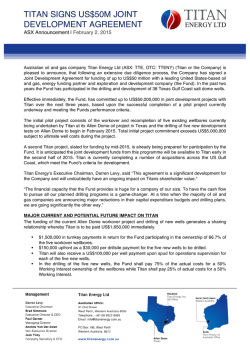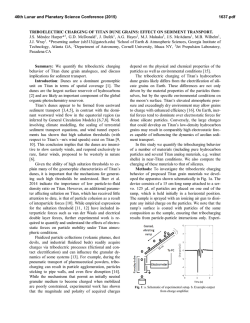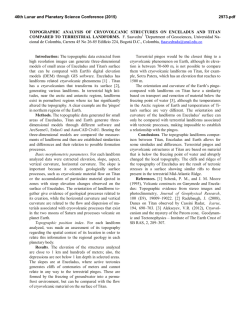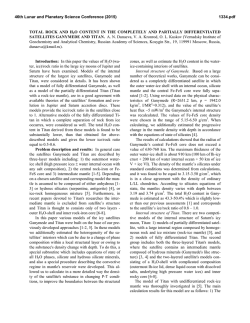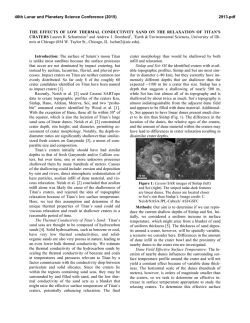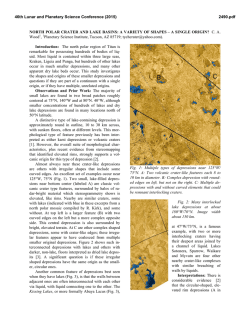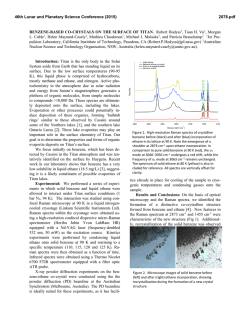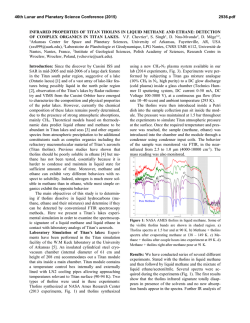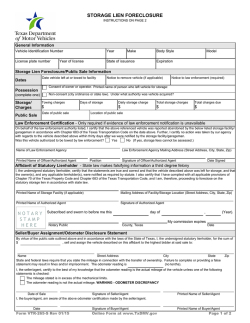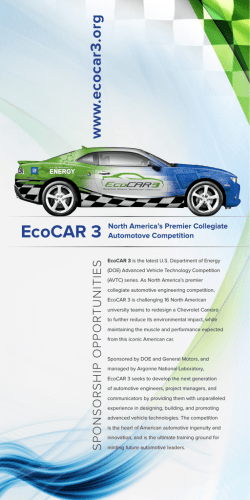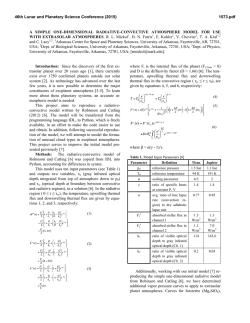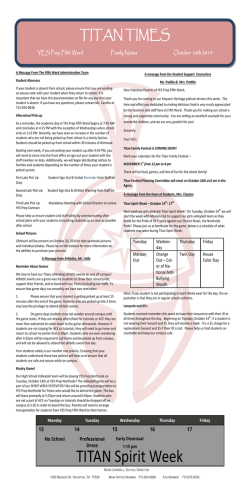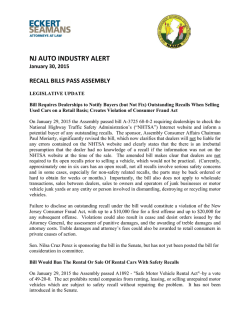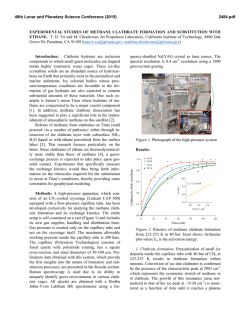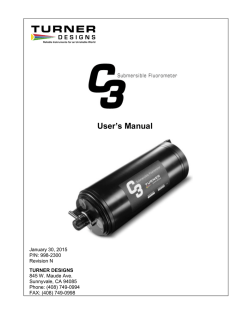
Titan Submarine : Vehicle Design and Operations Concept for the
46th Lunar and Planetary Science Conference (2015) 1259.pdf Titan Submarine : Vehicle Design and Operations Concept for the Exploration of the Hydrocarbon Seas of Saturn's Giant Moon. Ralph D. Lorenz1, Steve Oleson2, Jeff Woytach2, Robert Jones2, Anthony Colozza2, Paul 3 3 Schmitz2, Geoffrey Landis2, Michael Paul and Justin Walsh . 1 Space Exploration Sector, JHU Applied Physics Laboratory, Laurel, MD 20723, USA. ([email protected]) 2 NASA Glenn Research Center, Cleveland, OH. 3 Penn State Applied Research Lab, State College, PA, USA. Introduction: Saturn's frigid moon Titan, visited by the Huygens probe in 2005, has a thick atmosphere and three vast northern polar seas of methane and ethane : these seas are of particular interest for future exploration. These seas have a composition and conditions (1.5 bar, 92K) rather similar to those of Liquefied Natural Gas (LNG) on Earth. The largest, Kraken Mare, is 1000km in extent but of unknown depth: its complex shoreline morphology and evaporite deposits mapped by Cassini hint at a rich chemistry and climate history. We have developed a practical design for a robot submersible to explore this exotic environment, drawing on experience in terrestrial AUVs/UUVs as well as spacecraft systems. The proposed ~1-tonne vehicle, with a radioisotope Stirling generator power source, would be delivered to splashdown circa 2040, to make a ~90-day, ~2000km voyage of exploration around the perimeter, and across the central depths of, Kraken (Fig.1). Figure 1. A map of Titan’s seas. The vehicle would splashdown in the safe center of Kraken-1, then after sea trials, would sail north to observe tidal flow through the Ligeia-Kraken labyrinth and perhaps ‘sniff’ the more methane-rich liquid flowing equatorward from Ligeia. It will then explore the western shoreline of Kraken and investigate the tidal flow at the throat. This nominal mission entails cruise speeds of ~1m/s. Mission extensions could allow entry into Kraken-2 through the throat, and (if the channels are large enough) into Ligeia Mare. Design : In many ways a Titan submarine has autonomy requirements comparable with a terrestrial one and the propulsion/hydrodynamic considerations are similar. However, the direct transmission of worthwhile amounts of data over a billion miles to Earth requires a large antenna, implemented as a planar phased-array dorsal fin. (It was decided to simplify the mission to exclude a relay orbiter which would require significant propulsion and radioisotope power.) This antenna structure introduces a modest submerged drag penalty, as well as demanding judicious placement of large tanks for adequate buoyancy margin and surfaced stability. Particular challenges result from the hydrostatic environment – the range of liquid density that might be encountered (~450kg/m3-670 kg/m3) is much larger than the few per cent between fresh and salt water on Earth. Our point design assumes an ethane-rich composition (~650 kg/m3) in Kraken Mare : if Cassini data were to indicate methane-rich composition, the tanks would need to be enlarged. Fig. 2. The slender low-drag hull has propulsors at rear, and a large dorsal phased array antenna, at the front of which a surface camera is mounted in a streamlined cowl. A sidescan sonar, seafloor camera, and seafloor sampling system are visible on ventral surfaces. One of two long cylindrical buoyancy tanks is seen here, mounted high for surface stability. Also, while Titan's gravity is low (1.3 m/s2, similar to Earth's moon) such that the pressure at a given depth is only ~10% of that on Earth, at the >300m depths expected for Kraken, the pressure/temperature conditions are such as to permit nitrogen (the main constituent of Titan's atmosphere) to condense. Thus a conventional ballast tank design with pressurized atmospheric gas over liquid is untenable and a piston arrangement for buoyancy control is adopted, isolating the sea liquid 46th Lunar and Planetary Science Conference (2015) from a noncondensing pressurant (helium or neon). A further complication is the thermal design – bulky internal insulation is required to allow the 'waste' heat from the radioisotope power source to maintain benign internal temperatures, but the heat flux (rejected towards the rear) may nonetheless cause mild effervescence in the liquid which is thermodynamically much closer to local boiling than is water on Earth. In essence, we may face cavitation problems even when at rest : heat transfer uncertainties result, and sonar instrumentation must be sited away from the heat rejection areas to minimize the acoustic noise from bubbling. Fig.3. The submersible fits neatly in the USAF/ DARPA X-37 lifting body. Delivery: Whereas most planetary landers are somewhat equant in shape, and are comfortably accommodated in circularly-symmetric blunt sphere-cone entry shields, the elongate configuration of the submersible is not. However, the thick Titan atmosphere is a relatively gentle cushion for hypersonic entry from space, and we find our vehicle can be readily integrated with and deployed from a spaceplane carrier. Specifically, the submersible can fit within the cargo area of a modified Air Force X-37 lifting body (Fig.3 - which has demonstrated entry in similar aerothermodynamic conditions to Titan entry), and could exploit its crossrange flight ability to reach any desired delivery point a few km over Kraken. 1259.pdf marine would be jettisoned and the lifting body would sink, leaving the submarine floating to begin operations. (Alternatively, the submersible could be extracted in low level flight by parachute). Science Mission : The vehicle would use conventional propulsors to yaw around, using a sun sensor to determine the initial azimuth to Earth (Earth is always within 6o of the Sun as seen from Saturn) and begin communication, using a terrestrial radio beacon as a more precise reference. After initial trials to determine dynamic characteristics in-situ and verify guidance/ performance models, the vehicle would begin its scientific traverse. Navigation underway between communication fixes would be inertial, supplemented by acoustic doppler measurements. Most of the available ~1kW power is used alternately for submerged propulsion at up to ~1m/s, and for surfaced communication to Earth (roughly 16 hours per day). During northern summer (Titan's year is 29.5 Earth years long) Earth is continuously visible from Titan's arctic, although from some locations (Kraken sprawls from about 60 to 80 o N latitude) Earth would be below the horizon for a few days at a time. The vehicle would observe – and perhaps ultimately exploit - tidal currents in the sea, which follow a cycle once per Titan day, or 16 Earth days. When surfaced, as well as communicating with Earth, the vehicle would use a mast-mounted camera to observe the sea state and shoreline landscape, and would record meteorological observations. Measurement of the trace organic components of the sea, which perhaps may exhibit prebiotic chemical evolution, will be an important objective, and a benthic sampler would acquire and analyze sediment from the seabed. These measurements, and seafloor morphology via sidescan sonar, may shed light on the historical cycles of filling and drying of Titan's seas. Models suggest Titan's active hydrological cycle may cause the north part of Kraken to be 'fresher' (more methane-rich) than the south, and the submarine's long traverse will explore these composition variations. Conclusion : This study is only the first cut at a design, and has identified a number of technical trades and areas deserving closer study. Even with its planetary application aside, this exercise has forced us to look at submarine vehicle design drivers in a whole new way. Fig.4 1970s Space Shuttle ditching tests at Langley show lifting bodies can make safe landing on liquid. The lifting body would execute a soft water landing (Fig.4) at which point the backshell covering the sub- Acknowledgement: This work is supported by the NASA Institute for Advanced Concepts (NIAC) via Grant NNX14AR96A.
© Copyright 2025
